
The superfamily Apoidea is a major group within the Hymenoptera, which includes two traditionally recognized lineages, the "sphecoid" wasps, and the bees. Molecular phylogeny demonstrates that the bees arose from within the traditional "Crabronidae", so that grouping is paraphyletic, and this has led to a reclassification to produce monophyletic families.
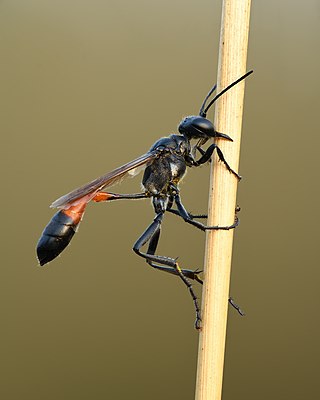
The Sphecidae are a cosmopolitan family of wasps of the suborder Apocrita that includes sand wasps, mud daubers, and other thread-waisted wasps.
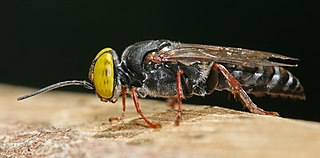
The Crabronidae is a large family of wasps within the superfamily Apoidea.

The Spheciformes is a paraphyletic assemblage of insect families which collectively comprise the "sphecoid wasps", and includes about 10 000 species. Larvae are carnivorous.

Aculeata is a subclade of Hymenoptera containing ants, bees, and stinging wasps. The name is a reference to the defining feature of the group, which is the modification of the ovipositor into a stinger. However, many members of the group cannot sting, either retaining the ovipositor, or having lost it altogether. A large part of the clade is parasitic.
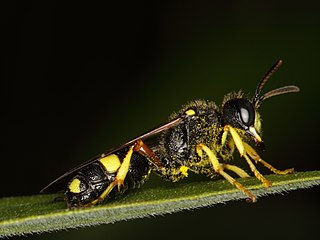
Cerceris is a genus of wasps in the family Philanthidae. It is the largest genus in the family, with 876 described species and 169 subspecies. The genus has a cosmopolitan distribution, with species on every continent.
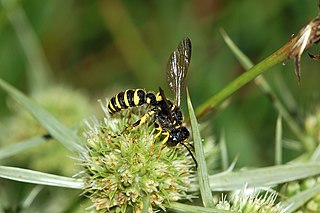
Philanthidae is one of the largest families of wasp in the superfamily Apoidea, with 1167 species in 8 genera. Most of the species are in the genus Cerceris.
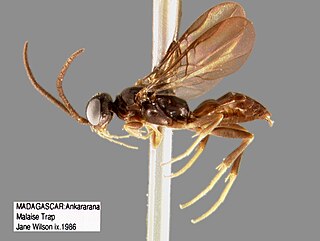
Heterogynaidae is a minor and disputed lineage of small spheciform wasps occurring in Madagascar, Botswana, Turkmenistan, Oman, the United Arab Emirates, and the Eastern Mediterranean area. The majority are dark in color and range in size from approximately 1.5 to 5.0 mm. Most specimens have been collected in arid climates, but one species from Madagascar is known to occur in a humid forest habitat. Although males have functional wings, heterogynaid females are typically brachypterous, a trait which is unique among spheciform wasps. Wing venation is reduced in both sexes. All species are diurnal, with the exception of H. nocticola. Other aspects of their biology are completely unknown, but details of their morphology have prompted researchers to hypothesize that they may be non-fossorial parasitoids adapted to hunt in tight spaces, such as under tree bark. This is speculative and has not yet been confirmed by actual observations of behavior. It is also possible that modifications of the female metasomal tergum VI and gonostyli may represent a unique prey transport mechanism, but this is also unconfirmed.

Astatidae is a cosmopolitan family of solitary wasps, peculiar for their males having very large compound eyes that broadly meet at the top of the head. The largest genus in this family is Astata, with about half of more than 160 species in the family.
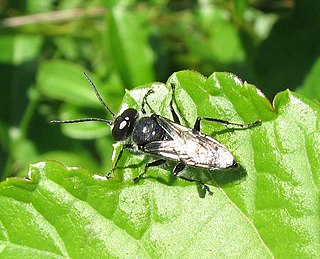
Astata is a cosmopolitan genus of solitary predatory wasps in the family Astatidae. They are known to prey on adults and nymphs of Pentatomidae. Astata is the largest genus in this subfamily, and is identified by features of its wing venation. The males of this genus and the related genus Dryudella have very large compound eyes that broadly meet at the top of the head.

Ammophilinae is a subfamily of thread-waisted wasps in the family Sphecidae. There are about 6 genera and more than 320 described species in Ammophilinae.

Cerceris clypeata is a species of weevil wasp in the family Philanthidae. It is found in North America.
Stigmus americanus is a species of aphid wasp in the family Pemphredonidae. It is found in North America.
Miscophus is a genus of square-headed wasps in the family Crabronidae. There are more than 180 described species in Miscophus.
Diploplectron ferrugineum is a species of wasp in the family Astatidae. It is found in North America.
Aphilanthopini is a tribe of wasps in the family Philanthidae. There are two genera and 13 described species are in the Aphilanthopini.

Cercerini is a tribe of wasps in the family Philanthidae. There are 2 genera and 937 described species in Cercerini. About 896 of these species are in the large genus Cerceris.
Cerceris yuwanensis is a species of wasp in the family Philanthidae that is found in Japan.
Clypeadon is a genus of wasps belonging to the family Philanthidae.
Mimesa is a genus of wasps belonging to the family Psenidae. The species of this genus are found in Europe and North America.













